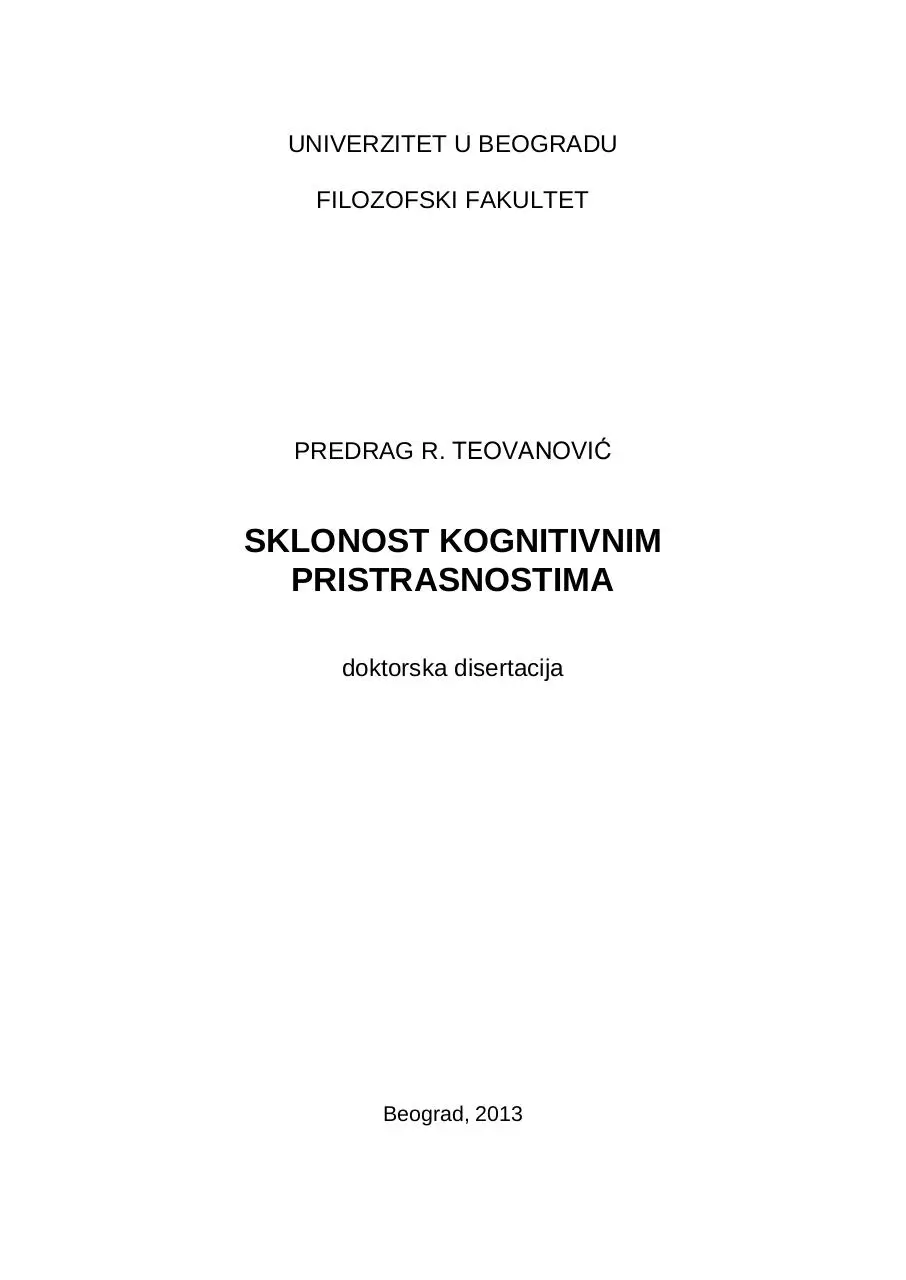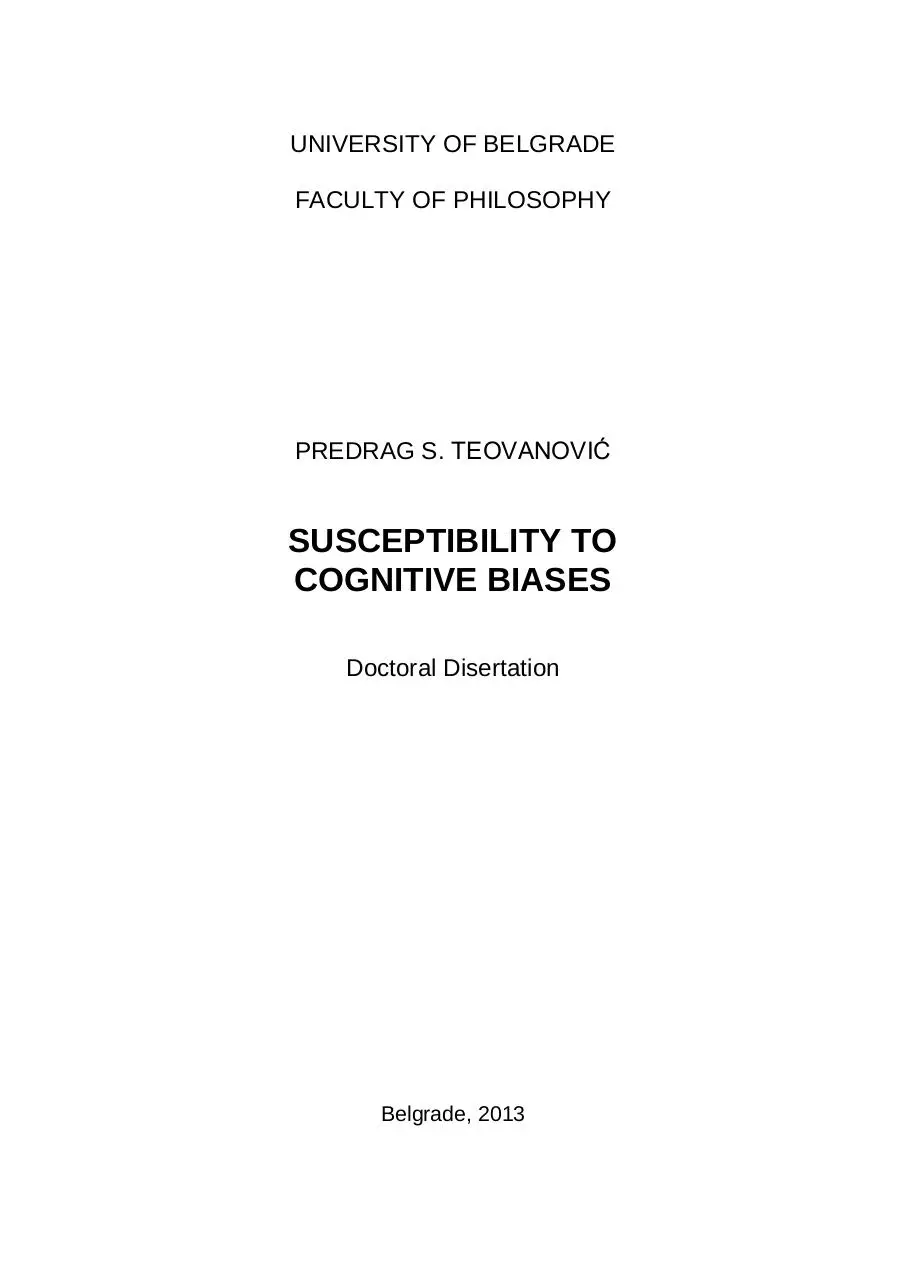teza pt (PDF)
File information
Author: Univerzitet u Beogradu
This PDF 1.6 document has been generated by Adobe Acrobat Pro 11.0.0, and has been sent on pdf-archive.com on 18/11/2013 at 03:01, from IP address 85.222.x.x.
The current document download page has been viewed 1459 times.
File size: 2.42 MB (206 pages).
Privacy: public file





File preview
UNIVERZITET U BEOGRADU
FILOZOFSKI FAKULTET
PREDRAG R. TEOVANOVIĆ
SKLONOST KOGNITIVNIM
PRISTRASNOSTIMA
doktorska disertacija
Beograd, 2013
UNIVERSITY OF BELGRADE
FACULTY OF PHILOSOPHY
PREDRAG S. TEOVANOVIĆ
SUSCEPTIBILITY TO
COGNITIVE BIASES
Doctoral Disertation
Belgrade, 2013
Mentor:
dr Goran Knežević, vanredni profesor, Univerzitet u Beogradu, Filozofski fakultet
Članovi komisije:
dr Aleksandar Kostić, redovni profesor, Univerzitet u Beogradu, Filozofski fakultet
dr Goran Opačić, docent, Univerzitet u Beogradu, Filozofski fakultet
dr Iris Žeželj, docent, Univerzitet u Beogradu, Filozofski fakultet
Belom albumu Bitlsa 1
1
„The Beatles is the ninth official album by English rock group the Beatles, a double
album released in 1968. It is commonly known as ’The White Album’, as it has no graphics or text
other then band’s name embossed on its plain white sleeve. The album was written and recorded
during a period of turmoil for the group, after visiting Maharishi Maresh Yogi in India and having a
particularly productive songwriting session in early 1968. (...) Many of songs were ’solo’ recordings,
or at least by less then full group, as each member began to explore his own talent.“ [Preuzeto
7/7/13 sa http://en.wikipedia.org/wiki/The_Beatles_(album)].
SKLONOST KOGNITIVNIM PRISTRASNOSTIMA
Kognitivne pristrasnosti, empirijski fenomeni sistematskog odstupanja ishoda
kognitivnih procesa od racionalnih normativa, istraženi su kroz osam studija korišćenjem
metodološkog i pojmovnog aparata psihologije individualnih razlika.
Efekat ukotvljavanja, koji se tiče predvidive sklonosti ljudi da zasnivaju procene
različitih vrednosti na irelevantnim numeričkim informacijama, bio je predmet prve studije.
Pored toga što potvrđuju postojanje krivolinijskog odnosa između stepena udaljenosti
kotve i veličine efekta ukotvljavanja, rezultati pokazuju da fluidna inteligencija oblikuje
kvadratnu funkciju ukotvljavanja na takav način da inteligentniji ispitanici imaju isti raspon
plauzabilnih odgovora kao i ostali subjekti, ali da plauzabilnim doživljavaju širi raspon
vrednosti kotvi. Inteligentniji obrazac odgovora može se razumeti kao strategija prihvatanja
niže stope rizika u širem rasponu vrednosti, što na bivarijatnom nivou rezultuje odsustvom
povezanosti inteligencije i ukupne veličine efekta ukotvljavanja. Direktan efekat
inteligencije na veličinu efekta ukotvljavanja zabeležen je u uslovima visoke reflektivnosti.
Ovi nalazi su u skladu sa pretpostavkom da, pored automatskih (selektivna dostupnost),
razumevanju efekta ukotvljavanja doprinose i serijalni procesi (nedovoljno podešavanje),
što je saglasno opštem stanovištu teorija dualnih procesa (TDP).
Pristrasnost uverenja, koja predstavlja efekat empirijskog statusa zaključka na ishode
procesa apstraktnog rezonovanja, bila je predmet druge studije. Efekat uverljivosti
dosledno je demonstriran na četiri osnovna tipa silogizma padom postignuća nakon
uvođenja konflikta između empirijskog i logičkog statusa zaključka. U skladu sa
očekivanjima TDP, faktor fluidne inteligencije predviđa individualne razlike u postignuću
ispitanika onda kada su uverljivost i validnost zaključka u konfliktu, ali ne i onda kada su
usaglašene. Pored toga, mere reflektivnog uma u uslovima konflikta ostvaruju značajne
inkrementalne doprinose razumevanju varijanse postignuća, što ukazuje na to da
individualne razlike u racionalnom mišljenju nisu svodive na inteligenciju.
Pristrasnost preteranog pouzdanja, koja se odnosi na sistematsku sklonost ljudi da
precenjuju vlastite sposobnosti, tradicionalno se izražava putem skora razlike između
subjektivne i objektivne verovatnoće davanja tačnih odgovora, i predstavlja predmet treće
studije. Kako bi se izbegao prigovor o algebarskom poreklu mere pristrasnosti u skorovima
postignuća (inteligencije), u trećoj studiji su empirijski razmotrene prednosti i nedostaci
alternativnih mera. Rezultati pokazuju da su subjektivne procene inteligentnijih subjekata
diskriminativnije, odnosno da su inteligentniji ispitanici pouzdaniji u svoje tačne i manje
pouzdani u svoje pogrešne odgovore, ali i da mere pouzdanja međusobno koreliraju visoko
bez obzira na to da li se odnose na tačne ili pogrešne odgovore. Može se pretpostavi da
subjekti kalibrišu svoje procene polazeći od stabilnog nivoa pouzdanja kao unutrašnje
kotve (faktor pouzdanja), a da ih potom serijalno podešavaju spram opažene težine zadatka
i kvaliteta odgovora. Kao potvrda učešća podešavanja u nastanku fenomena preteranog
pouzdanja mogu se uzeti nalazi koji govore o tome da su inteligentniji subjekti
nedvomisleno bolje kalibrisani.
Pristrasnost naknadne pameti je najmanje pouzdana pristrasnost obuhvaćena
istraživanjem, pokazuju rezultati četvrte studije. Iako su naknadne procene ispitanika, u
odnosu na inicijalne, bile niže nakon negativne i više nakon pozitivne povratne informacije,
nasumična povratna informacija ostvaruje značajno manji efekat u odnosu na ostale
istraživane normativno irelevantne varijable.
Sklonost zanemarivanju podataka o osnovnoj stopi u korist živopisnijih informacija
merena je instrumentom prikazanim u petoj studiji. Rezultati pokazuju da je skor
pristrasnosti negativno povezan sa merama inteligencije i kognitivne reflektivnosti.
Šesta studija potvrđuje robusnost efekta ishoda odluke donete u uslovima rizika na
procenu kvaliteta odluke. Bez obzira na to što je ispitanicima predočeno da je donosilac
odluke u hipotetičkim situacijama sa pozitivnim i negativnim ishodima baratao istim
informacijama o riziku, subjekti su sistematski atribuirali odgovornost donosiocima odluke,
zanemarujući vanličnosne determinante ishoda. Rezultati, međutim, pokazuju da izvore
individualnih razlika u podložnosti efektu ishoda ne treba tražiti u bazičnim dispozicijama
ljudskog ponašanja.
Efekat propalog ulaganja, kao predmet sedme studije, tradicionalno se navodi kao
jedan od pokazatelja averzije prema gubitku. Nakon nepovratnog troška, ljudi po pravilu
biraju da investiraju dodatne resurse, čak i onda kada je racionalno prestati sa daljim
ulaganjem. Ova sklonost je u vezi sa nepromišljenošću, konzervativnošću i resentimanom.
Konačno, u poslednoj studiji je korišćen multivarijacioni pristup fenomenima
kognitivnih pristrasnosti. S obzirom na heterogeno uzorkovanje relativno robusnih
fenomena, pošlo se od pretpostavke da istraživane pristrasnosti dovoljno verno
reprezentuju prostor normativne iracionalnosti. Analiza otkriva dve latentne dimenzije.
Crtistički posmatrani, ekstremi na faktorima normativne i ekološke racionalnosti nalikuju
predstavama o čoveku pristupa heuristika i pristrasnosti (KT čovek) i TDP (homo heuristicus +
animal symbolicum). Pored toga, nalazi ukazuju da model odnosa koji najbolje fituje
empirijskim podacima opisuje prirodu veze tri sržna TDP kontrukta kao kauzalni efekat
inteligencije na pristrasnosti koji je posredovan reflektivnošću. Drugim rečima, procesi tipa
2 dolaze do izražaja u uslovima visoke reflektivnosti. Rezultati su prodiskutovani i u
odnosu na ostale modele racionalnosti čoveka.
Ključne reči : kognitivne pristrasnosti; racionalnost; individualne razlike; teorije dualnih procesa
Naučna oblast: Psihologija
Uža naučna oblast: Viši mentalni procesi
UDK:159.95(043)
SUSCEPTIBILITY TO COGNITIVE BIASES
Cognitive biases, predictable deviations of cognitive processes' outcomes from
rational normatives, are examined in eight studies by using a methodological and
conceptual apparatus of differential psychology.
Anchoring effect, the common human tendency to rely too heavily on the first piece of
information offered, was the subject of the first study. Apart from confirming curvilinearity
of the anchor-distance function, results revealed that factor of fluid intelligence (gf) effects
this quadratic function in a way that more intelligent subjects have the same range of
plausible answers as other subjects, but they consider a wider range of anchor values as
plausible. Their response pattern can be perceived as a strategy of maintaining lower risk in
a wider range of values, which at the bivariate level results in the absence of correlation
between gf and anchoring effect. Direct gf effect on anchoring, observed in the conditions
of high cognitive reflection, speaks in favour of the assumption that, besides automatic
processes (selective accessibility), the anchoring effect is also influenced by serial processes
(insufficient adjustment), which is in compliance with the general notion of dual process
theories (DPT).
Belief bias, effect of the empirical status of a conclusion on the outcome of abstract
reasoning process, was the subject of the second study. Effect is consistently demonstrated
in four basic types of syllogism by a decline in achievement after introducing the conflict
between empirical and logical conclusion statuses. In compliance with DPT expectations,
gf predicts individual differences in the subjects’ achievements when plausibility and
validity of conclusion are in conflict, but not when there is a concurrence between them. In
the same conditions, the measures of a cognitive reflection incrementally contribute to the
(explanation) of the achievement variance, which can also be understood as a confirmation
of the assumption that individual differences in rational reasoning cannot be reduced to
intelligence.
People’s systematic tendency of overestimating their own abilities is traditionally
expressed through the score of difference between subjective and objective probability of
giving correct answers, namely the overconfidence effect. In order to avoid an objection about
the algebra origin of bias measure in the scores of achievement (intelligence), the third
study empirically investigates alternative measures. Results show that achievement
estimations of more intelligent subjects are more discriminative, particularly that the more
intelligent subjects are more confident about their correct answers while less confident
about the wrong ones. Nonetheless, confidence measures are highly intercorrelated,
regardless of whether they refer to correct or to wrong answers. It can be assumed that
confidence factor express stabile individual differences in self-generated anchors which
serve as a starting point for subsequent processes of (insufficient) adjustment. Findings that
bring to light better calibration of more intelligent subjects prove the role of type 2
processes in overconfidence effect.
Hindsight bias was the least reliable bias involved in the research as is shown by
results of the fourth study. Although subsequent estimations of confidence (in relation to
the initial ones) were lower after negative and higher after positive feedback, random
feedback achieves a substantially smaller effect in comparison to other examined
normatively irrelevant variables.
The following three studies were dedicated to a construction of psychometric
instruments. The tendency towards base rate neglecting (fifth study) is negatively correlated
with intelligence and cognitive reflection measures.
The sixth study confirms the robustness of outcome effect. Although a decision maker
in hypothetical situations with positive and negative outcomes had the same information
about risk, the subjects systematically attributed responsibility to decision makers, thus
ignoring that the outcome determinants existed outside them as well. However, results
show that the sources of individual differences in susceptibility to outcome effect should
not be sought in light of basic dispositions of human behavior.
Sunk cost effect was the subject of the seventh study. After the irreparable loss, people
as a rule choose to invest additional resources even when it is rational to stop further
investments. Results show that this tendency is correlated with thoughtlessness,
conservatism and resentment.
Finally, the last study uses a multivariate approach to the phenomena of cognitive
biases. Having in mind the heterogeneous sampling of robust phenomena, the starting
point was an assumption that examined biases are sufficiently truthful in representing full
range of normative irrationalities phenomena. Principal component analysis reveals two
latent dimensions. Factors of normative and ecological rationality resemble notions of man
in heuristics and biases approach (KT man) and in DPT (homo heuristicus + animal symbolicum).
Furthermore, findings show that the model which best fits empirical data describes nature
of association of three core constructs of DPT as a causal effect of intelligence on biases,
Download teza pt
teza_pt.pdf (PDF, 2.42 MB)
Download PDF
Share this file on social networks
Link to this page
Permanent link
Use the permanent link to the download page to share your document on Facebook, Twitter, LinkedIn, or directly with a contact by e-Mail, Messenger, Whatsapp, Line..
Short link
Use the short link to share your document on Twitter or by text message (SMS)
HTML Code
Copy the following HTML code to share your document on a Website or Blog
QR Code to this page

This file has been shared publicly by a user of PDF Archive.
Document ID: 0000135433.